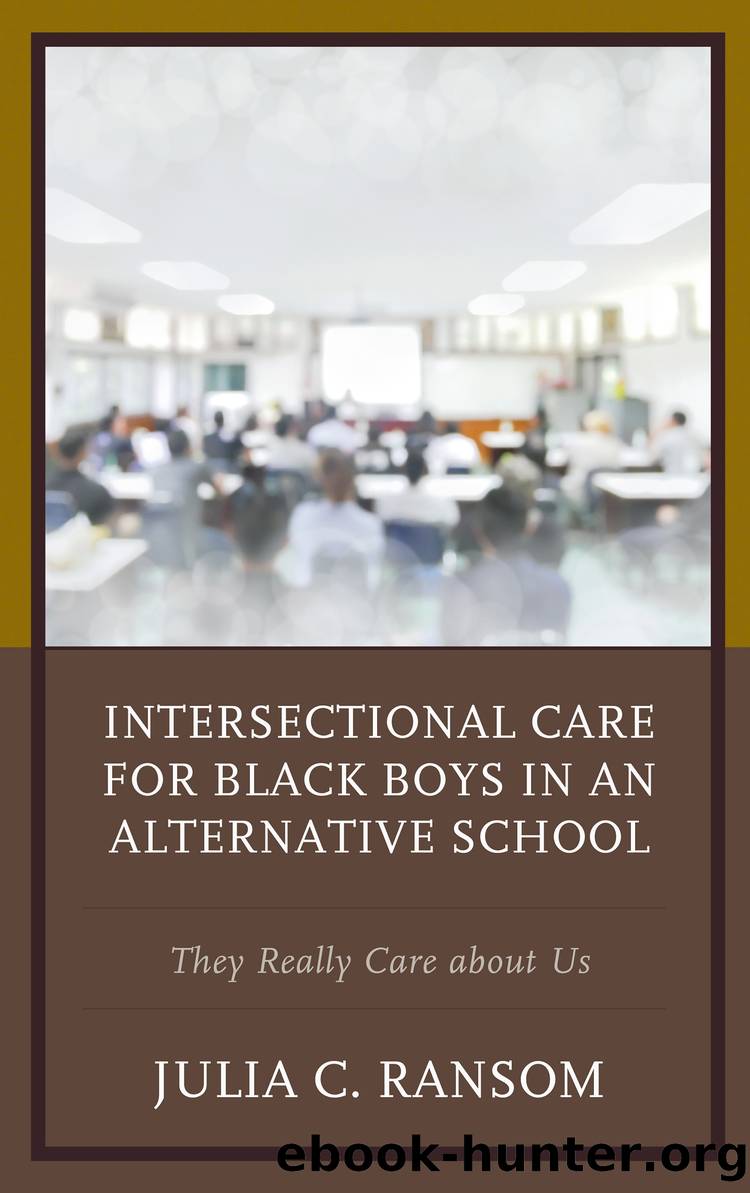Intersectional Care for Black Boys in an Alternative School by Ransom Julia C.;

Author:Ransom, Julia C.; [Ransom, Julia C.]
Language: eng
Format: epub
Publisher: Lexington Books/Fortress Academic
Published: 2018-11-13T00:00:00+00:00
Neutral Stance or Rejection of Stereotypes?: A Unique Case
Students illustrated their perspectives of race, class, and gender in interviews and during class. First, I will discuss a student who expressed he had neutral or no feelings about personal and social identity. Steve, a twenty-year-old, did not believe his race, class, and gender identity influenced his daily activities or his educational experiences. The nexus of power and privilege did not intersect in ways that manifested oppression for him at these identity points. He did express that he was a Black male from a low-income area, but his perception of the influence of these identities on the daily interactions was neither negative nor positive. Steve said that he did not think about any of those aspects in his daily life (personal communication, October 9, 2014). From a psychosocial perspective, the commitment to his identity without questioning might mean that he has not moved forward to other spaces in identity formation that call for questioning his commitment to his accepted identities (Crocetti, 2017). From a sociological intersectional perspective, that Steve did not think about his race, gender, and class, or express having experiences related to inequity as the result of existing at those intersections, could be the result of both being privileged in his interactions due to the nature of patriarchy and a lack of exposure to those outside of his race. In addition, his color-blind beliefs specifically could be the result of a color-blind ideology (Bonilla-Silva, 2017) prevalent throughout the school system and in teacher education as opposed to a color-conscious perspective that is beneficial for students and their own racial identification (Love, 2014; Ullucci & Battey, 2011).
Steve was from an area of the city that was Black and composed of people from the same class as himself. The AchieveEd student population is also majority Black. He considered himself as male; therefore, his gender privilege among women may buffer the oppression or inequity he could potentially experience. Rogers, Scott, and Way (2015) in their study on racial and gender identity from an intersectionality perspective, surveyed Black male adolescents in an all-Black, all-male high school. The authors noted that their students had a high centrality for gender, and that it exceeded the centrality that students had for race. Centrality was defined as the importance of gender to the self, or the importance students place on being male (Rogers, Scott, & Way, 2015). The finding of gender centrality points to the cultural milieu in which we live where being a man is privileged, and is the dichotomy of being a woman. This is changing slowly, but for many communities, the gender binary persists. The term âgender binaryâ as used here means âthe idea that there are only two gendersâ (GenderSpectrum, 2017, para 2). Hence, it is possible that like the students in Rogers, Scott, and Way (2015), Steve was from an all-Black neighborhood and attended an all-Black school, so this will influence the ways in which he framed race (as nonessential), and he prioritizes gender giving him that privilege.
Download
This site does not store any files on its server. We only index and link to content provided by other sites. Please contact the content providers to delete copyright contents if any and email us, we'll remove relevant links or contents immediately.
The Art of Coaching Workbook by Elena Aguilar(50157)
Trainspotting by Irvine Welsh(21063)
Twilight of the Idols With the Antichrist and Ecce Homo by Friedrich Nietzsche(18314)
The Secret History by Donna Tartt(18253)
All the Missing Girls by Megan Miranda(14833)
Cat's cradle by Kurt Vonnegut(14800)
Ready Player One by Cline Ernest(14058)
Talking to Strangers by Malcolm Gladwell(12911)
Fangirl by Rainbow Rowell(8812)
The Compound Effect by Darren Hardy(8539)
Thirteen Reasons Why by Jay Asher(8485)
The remains of the day by Kazuo Ishiguro(8426)
Periodization Training for Sports by Tudor Bompa(7939)
Tools of Titans by Timothy Ferriss(7844)
Wonder by R. J. Palacio(7753)
The Lover by Duras Marguerite(7603)
Change Your Questions, Change Your Life by Marilee Adams(7397)
A Court of Wings and Ruin by Sarah J. Maas(7301)
The Complete Stick Figure Physics Tutorials by Allen Sarah(7159)
